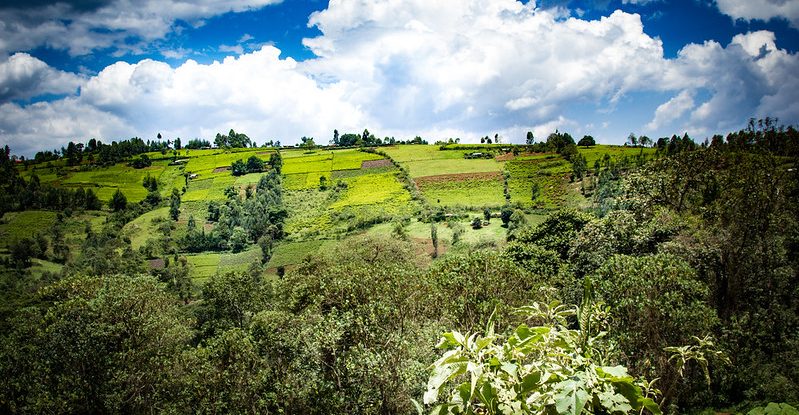In the latest assessment by the U.N. climate science panel, experts emphasized the potential benefits of natural solutions to combat global warming, especially land-based mitigation.
The report from the Intergovernmental Panel on Climate Change says that even if current national climate commitments are met, they will not effectively limit warming to 1.5 degrees Celsius beyond pre-industrial averages.
The world is facing at least 2.2 degrees C if not more, without taking drastic action, the report says.
While fossil fuels are identified as the main culprit, there is consensus that a properly managed land-use sector, which includes agriculture and forestry, can contribute to emissions reductions, remove and store carbon dioxide.
The land-use sector contributes about 25 percent to emissions, but could contribute twice this amount to emission reductions.
Through land restoration and the use of integrated land management techniques, academics say, the ever-increasing trajectory of global warming will be reduced, while benefiting biodiversity and ecosystems.
It is no mean feat to restore degraded land – estimated to be a whopping 25 percent of land area worldwide.
It is here that Open Forest Protocol (OFP), an innovative open source blockchain-based platform, aims to make a big difference, closing gaps that currently make accurate and transparent measuring, reporting and verification (MRV) a challenge.
The web-based application is designed to provide smallholders, land users, non-governmental organizations (NGO), governments and other stakeholders the capacity to measure and verify the carbon on their land so they can recoup results-based payments.
Use of blockchain creates a transparent and secure means to store information, which cannot be changed or altered.
“It’s intended as a community-based project where different groups of people can look at the data, then if it’s validated by the community, it goes on a blockchain system so the data are transparent,” said OPF founder Frederic Fournier, during an interview on the sidelines of U.N. COP26 climate talks in Glasgow last year.
“That’s the first step — the second step of the project is that we will then actually improve the MRV capacity to grant access to government finance for those projects that don’t have access.”
Ultimately, the idea is that it will create a standardized system for creating carbon credits for trade on voluntary carbon markets based upon MRV, he said, adding that accuracy is vital if credits are to be traded or exchanged as offsets for government or company emissions.
Demand is projected to increase exponentially as countries and companies scramble to offset their emissions and try and meet targets.
Currently, reforestation efforts are often hampered by a lack of accuracy around data, making it difficult to determine whether it reflects the true status of trees in the landscape.
Last month, OFP, which is a partner with the Center for International Forestry Research and World Agroforestry (CIFOR-ICRAF), signed a pact with Ivory Coast to work with local communities and a non-governmental organization to sustainably reforest and restore 5,067 hectares of degraded forest land in the Gorké forest region.
It is one of 27 projects involved so far.
Users can monitor the web interface on a dashboard showing a list of projects, assign field agents to a specific project, check the data once it has been gathered from the field, and double check it. Afterwards, data can be sent via the dashboard for validation within the blockchain community – the third party that runs it.
“This is a different type of approach,” said Radoslav Dragov, who oversees business development outreach at OFP. “It’s a community-based, open-source, low-cost approach, which makes it a game changer – we’re trying to break down the silos and create something that really makes use of new technology and can empower people from around the world to plant trees, which is good for the environment, but also they should get something in return.”
Most reforestation projects cannot currently access carbon financing if they are smaller than 1,200 hectares, based on the analysis of all Verra reports to date and discussions with projects trying to become Verra certified, say Dragov and Fournier who are hopeful that through OFP, tree planting will lead to more carbon financing, which will lead to more planting.
“Nature-based solutions could provide around 30 percent of the cost-effective mitigation that is needed by 2030 to stabilize warming to below 2°C,” Fournier said. “Nature-based solutions are obviously not the only thing, but certainly one of the very top ways we can tackle climate change.”
The company, which has 25 employees, is headquartered near Geneva. It is developing its international presence in Costa Rica, Panama, Colombia and South Korea and is expanding its presence in Nairobi.
We want you to share Forests News content, which is licensed under Creative Commons Attribution-NonCommercial-ShareAlike 4.0 International (CC BY-NC-SA 4.0). This means you are free to redistribute our material for non-commercial purposes. All we ask is that you give Forests News appropriate credit and link to the original Forests News content, indicate if changes were made, and distribute your contributions under the same Creative Commons license. You must notify Forests News if you repost, reprint or reuse our materials by contacting forestsnews@cifor-icraf.org.
